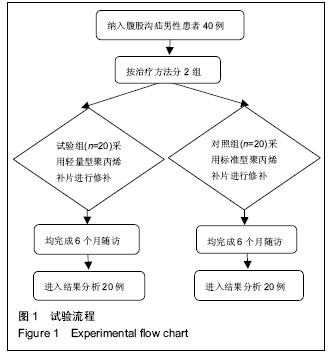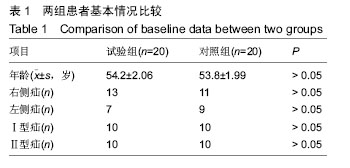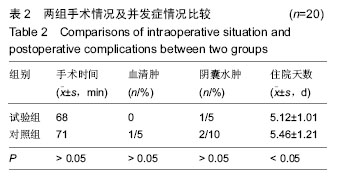| [1] 中华医学会外科学分会疝和腹壁外科学组, 中国医师协会外科医师分会疝和腹壁外科医师委员会.成人腹股沟疝诊疗指南[J].中华外科杂志, 2012,52(7): 481-484. [2] Inan I,Myers PO,Hagen ME.Amyand'S hernia: 10 years experience.Surgeon.2009;7(4): 198-202.[3] Hureibi KA,MeLatehie GR,Kidambi AV.Is herniorrhaphy useful and safe? Eur J Radiol. 201l;80(2):e86-90.[4] 陈智平.腹腔镜疝修补术与开放式无张力疝修补术的对比研究[J].临床医学工程,2011,18 (6):105-106.[5] 狄挺松.Bassini法、Mcvay法与补片修补法在腹股沟斜疝治疗中的效果对比[J].中国医药指南, 2013,11(36):78-79.[6] 郜国均,张萍.聚丙烯平片修补腹股沟疝85例应用体会[J].中国药物经济学,2013,8(S3): 23-25. [7] 刘小胜.手术修补术结合中药治疗中老年疝气60例临床体会[J].实用中西医结合临床,2013,13(8):83-84. [8] 徐颖璐,李建海.腹股沟疝无张力修补术切口感染的影响因素分析及干预对策[J].中国现代医生, 2013,51(32): 59-60. [9] 付敬伟.Millikan改良法疝修补术治疗马鞍疝121例[J].中国现代普通外科进展,2013,16(10):45-46. [10] 沙广春.疝环充填式无张力修补术在成人腹股沟疝中的应用研究[J].吉林医学,2011,32(2):101-102. [11] 鲍荣学.充填式无张力疝修补术治疗腹股沟疝72例的临床分析[J].中国医药指南,2011,9(24):743-744. [12] 何川,陈磊,蔡波,等.充填式无张力疝修补术治疗腹股沟疝155例疗效分析[J].中国医药科学, 2011,1(14):105-106. [13] 曹佩银.充填式无张力疝修补术临床应用研究[J].中国实用医药,2010,5(10):984-995. [14] 顾彬.无张力疝修补手术治疗腹股沟疝效果分析[J].医学信息:上旬刊, 2011,24(8): 833-834. [15] 韩重鑫,梁锦积.68例腹股沟疝无张力修补术临床分析[J].中国医药科学,2011,1 (5):213-215. [16] 张程鹏.指拨分离法在完全腹膜外疝修补入路及操作空间建立中的应用[J].中华疝和腹壁外科杂志:电子版, 2013, 7(12):175-177.[17] Negro P,Gossetti F,Dassatti MR,et al. Bioabsorbable Gore BIO-A plug and patch hernia repair in young adults.Hernia.2012;16(1):121-122.[18] Ratto C,Litta F,Parello A,et al.Gore Bio-A Fistula Plug: a new sphincter-sparing procedure for complex anal fistula.Colorectal Dis. 2012;14(5):e264-e269.[19] Campanelli G,Pascual MH,Hoeferlin A,et al. Randomized, controlled, blinded trial of Tisseel/ Tissucol for mesh fixation in patients undergoing Lichtenstein technique for primary inguinal hernia repair: results of the TIMELI trial.Ann Surg. 2012; 255(4): 650-657.[20] Chastan P.Tension-free open hernia repair using an innovative self-gripping semi-resorbable mesh Hernia. 2009;13(2):137-142.[21] Kingsnorth A,Gingell-Littlejohn M,Nienhuijs S,et al.Randomized controlled multicenter international clinical trial of self-gripping ParietexTM ProGripTM polyester mesh versus lightweight polypropylene mesh in open inguinal hernia repair: interim results at 3 months.Hernia.2012;16(3):287-294.[22] Amid PK,Shulman AG,Lichtenstein IL,et al. Biomaterials for abdominal wall hernia surgery and principles of their applications.Langenbecks Arch Chir.1994;379(3): 168-171.[23] Beets GL,van Geldere D,Baeten CG,et al.Long-term results of giant prosthetic reinforcement of the visceral sac for complex recurrent inguinal hernia.Br J Surg. 1996; 83(2):203-206.[24] Schumpelick V,Conze J,Klinge U.Preperitoneal mesh-plasty in incisional hernia repair: a comparative retrospective study of 272 operated incisional hernias.Chirurg.1996;67(10):1028-1035.[25] Klosterhalfen B,Klinge U,Schumpelick V.Functional and morphological evaluation of different polypropylene-mesh modifications for abdominal wall repair.Biomaterials.1998;19(24):2235-2246.[26] Klinge U,unge K,Stumpf M,et al.Functional and morphological evaluation of a low-weight,monofilament polypropylene mesh for hernia repair.J Biomed Mater Res.2002;63(2):129-136.[27] Rosch R,Junge K,Quester R,et al.Vypro Ⅱ mesh in hernia repair: impact of polyglactin on long-term incorporation in rats.Eur Surg Res. 2003;35(5):445-450. [28] Junge K,Rosch R,Krones CJ,et al.Influence of polyglecaprone 25(Monocryl) supplementation on the biocompatibility of a polypropylene mesh for hernia repair.Hernia.2005;9(3):212-217.[29] Tanaka K,Mutter D,Inoue H,et al.In vivo evaluation of a new composite mesh( 10% polypropylene /90% poly-L-lactic acid) for hernia repair.J Mater Sci Mater Med.2007;18(6):991-999.[30] Di Vita G,Patti R,Barrera T,et al.Impact of heavy polypropylene mesh and composite light polypropylene and polyglactin 910 on the inflammatory response.Surg Innov.2010;17(3):229-235.[31] Orenstein SB,Saberski ER,Kreutzer DL,et al. Comparative analysis of histopathologic effects of synthetic meshes based on material,weight, and pore size in mice.J Surg Res.2012;176(2):423-429.[32] d'Acampora AJ,Kestering Dde M,Soldi Mda S,et al. Experimental study comparing the tensile strength of different surgical meshes following aponeurotic-muscle deformity synthesis on Wistar rats.Acta Cir Bras. 2007; 22(1):47-52.[33] Post S,Weiss B,Willer M,et al.Randomized clinical trial of lightweight composite mesh for Lichtenstein inguinal hernia repair.Br J Surg.2004;91(1):44-48.[34] Bringman S,Wollert S,Osterberg J,t al.Three-year results of a randomized clinical trial of lightweight or standard polypropylene mesh in Lichtenstein repair of primary inguinal hernia.Br J Surg. 2006;93(9): 1056-1059.[35] Polish Hernia Study Group,?mietański M.Randomized clinical trial comparing a polypropylene with a poliglecaprone and polypro-pylene composite mesh for inguinal hernioplasty.Br J Surg. 2008;95(12): 1462-1468.[36] Koch A,Bringman S,Myrelid P,et al.Randomized clinical trial of groin hernia repair with titanium-coated lightweight mesh compared with standard polypropylene mesh. Br J Surg. 2008;95(10): 1226-1231.[37] Nikkolo C,Lepner U,Murruste M,et al.Randomised clinical trial comparing lightweight mesh with heavyweight mesh for inguinal hernioplasty. Hernia. 2010;14(3): 253-258.[38] Sadowski B,Rodriguez J,Symmonds R,et al. Comparison of polypropylene versus polyester mesh in the Lichtenstein hernia repair with respect to chronic pain and discomfort.Hernia.2011;15(6):643-654.[39] Khan LR,Liong S,de Beaux AC,et al.Lightweight mesh improves functional outcome in laparoscopic totally extra-peritoneal inguinal hernia repair.Hernia. 2010; 14(1): 39-45.[40] O'Dwyer PJ,Kingsnorth AN,Molloy RG,et al. Randomized clinical trial assessing impact of a lightweight or heavyweight mesh on chronic pain after inguinal hernia repair.Br J Surg.2005;92(2):166-170.[41] Agarwal BB,Agarwal KA,Mahajan KC. Prospective double-blind randomized controlled study comparing heavy-and lightweight polypropylene mesh in totally extraperitoneal repair of inguinal hernia:early results. Surg Endosc.2009;23(2):242-247.[42] Chowbey PK,Garg N,Sharma A,et al.Prospective randomized clinical trial comparing lightweight mesh and heavyweight polypropylene mesh in endoscopic totally extraperitoneal groin hernia repair.Surg Endosc. 2010;24(12):3073-3079.[43] Chui LB,Ng WT,Sze YS,et al. Prospective, randomized, controlled trial comparing lightweight versus heavyweight mesh in chronic pain incidence after TEP repair of bilateral inguinal hernia.Surg Endosc. 2010; 24(11):2735-2738.[44] Bittner R,Leibl BJ,Kraft B,et al.One-year results of a prospective,randomised clinical trial comparing four meshes in laparoscopic inguinal hernia repair (TAPP). Hernia.2011;15(5):503-510. |
.jpg)





.jpg)